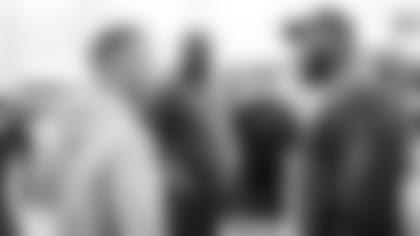The Packers prepare to play the Detroit Lions in a NFC Wild Card playoff game on December 31, 1994. The Packers won 16-12.
Greg from San Ramon, CA
When the first domes were built, architects did a study to determine if Lambeau Field was fit to have a roof. Any truth to it?
Today, the mere suggestion of putting a dome over Lambeau Field sounds like sheer blasphemy. Nothing would ruin the character of Lambeau or the proud image of Packers fans more than a dome. I also think it would rob the franchise of its identity, just like the Vikings lost their selfhood when they moved inside in 1982.
But there was a time when it didn't seem like such a preposterous idea, just like it seems more than doable at the moment that the Packers could win a Super Bowl by scoring three straight postseason victories indoors for the first time ever. Who among older Packers fans ever thought we might see that day?
Actually, the first time I'm aware of anyone connected to the Packers talking about a dome was Curly Lambeau. Just goes to show what a visionary he was. In 1943, believe it or not, Lambeau told Jack Cuddy, a United Press sportswriter, that within five years once the war ended he expected pro football owners to begin building roofs over their stadiums to eliminate the hazards of weather.
The next Packers official to broach the subject of domes, as far as I know, was Vince Lombardi. In August 1966, he admitted consideration was being given to building a dome over Lambeau Field. He said it was architecturally feasible, as long as the ends of the stadium remained open. That was a little more than a year after Houston's Astrodome, the first all-purpose domed stadium, opened. Lombardi said it would take two years to build a roof over Lambeau, but emphasized "it's just in the talking stage."
Nothing came of those talks, but the subject didn't die as more domes were built and the schedule called for the Packers to play more late-season games at home. Then in the early 1980s, the Packers had another study done to determine if it was feasible to put a dome over Lambeau.
In fact, while I was still writing for the Green Bay Press-Gazette in October 1981, I reported that David Geiger had been approached by members of the Packers organization about doing the study and that members of the Packers executive committee had recently toured the Silverdome in Pontiac, Mich., to gain a better understanding of what would be involved if the Packers built a dome.
Seven months later, there was a testy exchange at the Packers' shareholders meeting when a shareholder asked if board members were looking into putting a dome over Lambeau and executive committee member Jerry Atkinson all but cut him off. "If you're not thinking about it, you're not doing your job," shareholder Jim Boex shot back.
At the time, the Packers were 15 years into their post-Lombardi swoon and there was serious concern about the future of the franchise if it didn't keep up with the times. The feasibility study was completed a year later, but, again, nothing came of it.
Larry from Ensenada, Baja California
I'm curious to know about the history of the Packers' waiting list for tickets. When was the list created? How many tickets move each year? Is it true they can be passed down from generation to generation? Is there a limit to how many one can own?
I posed your question to Mark Wagner, our director of ticket operations. He tells me there's no record of when the waiting list started, but he believes it was soon after the stadium started selling out on a season-ticket basis. That first happened in 1961.
As you may know, there are two season-ticket packages: a seven-game Green and a three-game Gold. Mark said in a typical year roughly 150 to 200 seats become available.
Seats can be transferred within the family, up to and including first cousins, by filling out a notarized transfer form. People on the list can request up to four tickets.
Finally, I don't believe there is any limit on how many tickets longtime ticketholders can own. The people who purchased large blocks of season tickets prior to 1959 did so to save the franchise. If not for them there would be no Lambeau Field or Green Bay Packers today, so there's good reason for why the organization remains loyal to ticketholders and their families who date to the 1950s and earlier.
In 1940, the Packers sold a record 2,800 season tickets. The next year, they had to call an emergency meeting of city businessmen where they revealed that they needed to almost double that total or, otherwise, they might not find enough other teams willing to play in Green Bay. In 1957, when their new 32,154-seat stadium opened, the Packers were hoping to sell it out on a season-ticket basis, but 8,000 tickets went unsold. And those season tickets could have been purchased for $6.75. The $6.75 was the total price of a north end zone season ticket for the Packers' three home games. And kids tickets were even cheaper.
Will of Green Bay
When new City Stadium was built, who were the movers and shakers in Green Bay who got it done and how much pressure did the league apply?
Fred Leicht, who was a member of the Packers executive committee from 1935 to 1959 and head of its stadium or grounds committee during that time, was certainly one of the people who took a lead role. Verne Lewellen, an attorney and general manager of the Packers from 1953 to 1959, also was heavily involved and maybe the team's most prominent spokesman during that period. Russ Bogda was president of the Packers when the stadium was built. Packers board members Tony Canadeo and Jerry Atkinson served as co-captains of the "Citizens Committee for the Stadium Team."
In the spring of 1957, as the stadium was being constructed, City Attorney Clarence Nier was named president of the newly formed Stadium Commission and probably was the foremost powerbroker over stadium decisions for the next 30 years or so.
By the late 1930s, if not before, other NFL owners were complaining about the gate receipts in Green Bay and debating whether to turn the Packers into a traveling team. The dissatisfaction only intensified until new City Stadium was built in 1957. The year before, when the push to build a new stadium was reaching its climax, Leicht told a crowd at one gathering, "There is no kidding ourselves. We are doing more than deciding on a stadium. We are deciding whether we want the Packers in Green Bay." In 1955, the Packers received $264,933 in gate receipts from their six road games. That exceeded, by more than $100,000, the amount the Packers paid to visiting teams that year.
The Green Bay Press-Gazette was another important and early supporter of building a new stadium. As early as 1951, sportswriter Art Daley led his Sports Cocktail column with this sentence, "The City of Green Bay someday must give serious consideration to the construction of a new stadium!" The Sullivan-Wallen American Legion Post also played a lead role in encouraging the city to build a stadium.
Finally, there was at least one other large group involved. In January 1956, Mayor Otto Rachals named a 16-man advisory committee on a new stadium. Members were Howie Blindauer, Cletus Chadek, Wally Counard, Don Engebos, Norbert Jacobs, J.C. McGinnis, L.L. Mohlke, Peter M. Platten, Chester Racine, John Rose, Ben Rosenberg, John Scannell, Al Swanstrom, Frank Walker, Ed Wolf and Carl Zoll.

A goal post comes down after the Packers defeated the Dallas Cowboys 21-17 in the 1967 NFL championship game.
John from Grand Rapids, MI
Growing up in Green Bay and attending Packers games, I recall tearing down the goal posts after big victories. In fact, I've unsuccessfully tried to see myself in footage taking down the south goal post after the Ice Bowl. Did fans of other teams tear down goal posts? How did the tradition start and end?
Can't tell you the history of the tradition and how it started, but I believe it was fairly common for college and pro football fans to rush the field and tear down goal posts after big wins. I remember fans doing it in Green Bay after the Packers won the 1961, '65 and '67 NFL championship games at home. Over time, laws were passed and fines were established for anyone who went onto the field after games, and more officers and security folks were there to protect it. Basically, that's what put an end to the tradition.
John from Jacksonville, Fla.
In either 1959 or '60, I attended a home game in Green Bay and sat in the kids' section. In those days, a chain-link fence surrounded the stadium and the bathrooms were in one-story cinder block buildings that backed up to the fence. So it was possible to climb the fence to get on top of the bathrooms and then drop down inside the stadium. I remember seeing a member of the stadium staff standing on top of a bathroom building with a rubber hose in his hand, presumably to whack anyone trying to get in without a ticket. This made a big impression on me. Do you remember that?
About two weeks before the first game played at new City Stadium in 1957, the Packers announced that no kids would be allowed into the stadium without a ticket. The announcement was necessary because it had been the custom at old City Stadium to allow kids in for free. They could walk through the gates with their parents or climb over the wooden fence surrounding the field and sit where they wanted, including on the grass behind the end zone. When the new stadium opened, the Packers ended the practice, but created a separate kids section and charged only 75 cents per ticket. I don't remember seeing anyone with a hose, but I recall policemen or ushers standing guard, especially around the bathrooms. They'd watch for fans trying to sneak in – they weren't all kids, as I remember – and chase them out.
Paul from Milwaukee, WI
Can you explain why the Packers played a home playoff game at Milwaukee County Stadium, rather than Lambeau, in the 1960s?
They played the Western Conference Championship there following the 1967 season. That was the first year the NFL split into four divisions and added a layer to its postseason. The game pitted the Packers, winners of the Central Division, against the Los Angeles Rams, winners of the Coastal Division. I don't know if Vince Lombardi ever explained why the Packers decided to play the game in County Stadium, but he went out of his way during his 10 years as general manager to give Milwaukee a fair shake when it came to splitting games between the cities. I also think he liked playing in Milwaukee, maybe as much as playing in Green Bay. He was fond of big cities.
Frank from Las Vegas, NV
Enjoyed your comments on the Ice Bowl fans, but there were more people there than just those who lived in Green Bay because Milwaukee ticketholders also were offered tickets. And I believe Green Bay ticketholders were limited to two seats even if they had more tickets in their names.
True, fans in Milwaukee were given priority to buy the tickets for the 1967 NFL Championship that Green Bay ticketholders passed on, just as Green Bay fans were given priority to purchase Western Conference Championship tickets that Milwaukee ticketholders didn't take. But the letter Lombardi sent to ticketholders, dated Dec. 1, actually told people they were being billed for their full allotment, but only had to pay for the tickets they ordered. No doubt, more than just fans from the Green Bay area were at the Ice Bowl. But considering the game was blacked out on Green Bay television and nobody knew in advance how cold it was going to be, I wonder if that many people actually passed on their tickets.
Phyllis from Jordan, MN
We took the tour of Lambeau Field and enjoyed it a lot. The tour guide said Lambeau was open 363 days a year. What days is it closed?
The Atrium is closed to the public on Christmas, Thanksgiving and Easter, barring a game on the first two holidays.
* *















